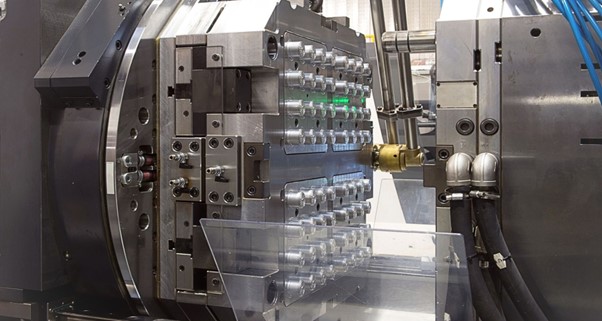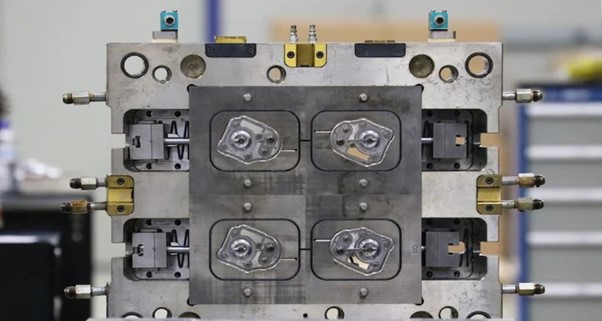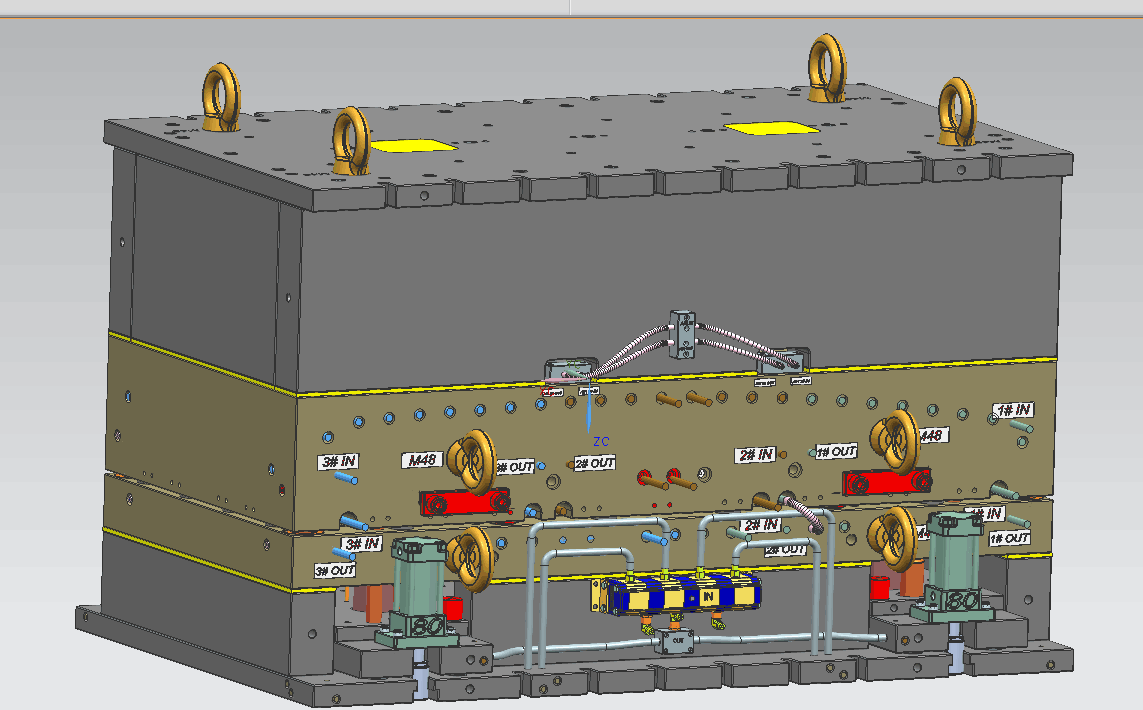Herramientas de moldeo por inyección de plástico
Herramienta de moldeo por inyección de plástico La fabricación de moldes es delicada e intrincada, por lo que incluso un molde de inyección de plástico de una sola cavidad puede costar hasta $5000. Este proceso de fabricación implica el uso de herramientas sofisticadas, tecnología moderna y fabricantes de moldes cualificados. Las herramientas de moldeo por inyección de plástico se aplican principalmente en la producción en masa de productos de plástico. Este proceso utiliza moldes de inyección y plástico fundido para formar piezas de especificaciones exactas con formas y tamaños variables. El proceso comienza con el calentamiento del plástico, a menudo en forma de perlas, y lo suministra a la fábrica.
Este plástico fundido se transfiere a una máquina de moldeo por inyección y se inyecta en la cavidad del molde. En los moldes de inyección de plástico, los canales permiten que los refrigerantes fluyan alrededor del plástico caliente en la cavidad. Esta circulación también ayuda a enfriar el plástico, lo que es vital para aumentar la velocidad de solidificación y mejorar la producción.
Para entender cómo funciona el proceso de moldeo por inyección, es necesario tener un conocimiento básico de las herramientas de moldeo por inyección: qué son, cómo funcionan, dónde conseguirlas y cuáles son las más eficaces para aplicaciones específicas. Este artículo proporciona toda la información esencial que un lector puede necesitar antes de utilizar una herramienta de moldeo por inyección.

Breve descripción de las herramientas de moldeo por inyección de plástico
Molde de inyección de plástico Las herramientas son piezas cruciales de las máquinas de moldeo. Ayudan a producir varias piezas simultáneamente. Estos moldes, sencillos o complejos, tienen una larga vida útil y pueden crear miles de piezas durante su vida útil.
Además, estos moldes suelen estar fabricados con materiales de alta resistencia, como acero o aluminio, y tienen guías que unen el punto de inyección con el molde para permitir el flujo del plástico líquido fundido. Además, los orificios de refrigeración ayudan a enfriar y solidificar el material plástico. Cada molde consta de dos placas centrales principales: Placa Aque sujeta firmemente las piezas durante el proceso de moldeo por inyección, y Placa Bque suele utilizarse para abrir y cerrar el molde y expulsar las piezas o productos finales.
Diferentes funcionalidades de las herramientas de moldeo por inyección
Como ya se ha comentado, las herramientas de moldeo son un componente crucial en el moldeo por inyección de plásticos, ya que cumplen varias funciones fundamentales:
Guiar plástico fundido: Canal a través del cual puede fluir el plástico fundido desde el cilindro de inyección (barril) hasta la cavidad del molde.
Enfriamiento: Enfría la pieza moldeada hasta que fragua y se solidifica con la forma y el tamaño deseados. El control de la temperatura del molde es vital para permitir que el moldeo se enfríe a la velocidad adecuada para evitar distorsiones y tensiones. Normalmente, el agua fluye a través de canales hechos en el molde, como en el caso del sistema de refrigeración del motor de un automóvil.
Ventilación: Cuando el molde está cerrado, la ventilación proporciona una vía de escape para el aire atrapado. Si la pieza moldeada no estuviera ventilada, tendría huecos (burbujas de aire o cavidades), lo que daría lugar a un mal acabado superficial.
Expulsión de piezas: Los pasadores eyectores ayudan a expulsar el molde terminado fuera del molde. Estas funciones demuestran la importancia de la herramienta de moldeo para lograr una alta calidad y cero defectos o mantener las piezas de plástico.
Materiales compatibles utilizados para fabricar moldes de moldeo por inyección
Molde de inyección de acero para herramientas
La elección definitiva del material para las herramientas de moldeo por inyección de plástico depende del número de piezas que se vayan a producir, del tipo de plástico que se vaya a moldear y de la vida útil de la herramienta. Cada material incorporado a estas herramientas tiene sus características. Estos son algunos de los materiales más comunes
Acero: Las herramientas de acero se utilizan mucho en el moldeo por inyección de plásticos por su dureza y capacidad para soportar el desgaste. Son relativamente baratas y fáciles de mecanizar, por lo que resultan adecuadas para muchos usos. Desde piezas de rasgos sencillos hasta componentes de formas complejas, estas herramientas tienen un valor incalculable. Su uso es indispensable en piezas de automoción, aeronaves, interiores y exteriores. Sin embargo, los moldes de acero pueden ser propensos a la corrosión, desgastarse en condiciones duras y requerir un mantenimiento frecuente.
Aluminio: Estas herramientas son las preferidas porque son ligeras y resisten la corrosión. Son fáciles de mecanizar y permiten fabricar diversos productos médicos, electrónicos y piezas de automóvil. No obstante, los moldes de aluminio no son tan duraderos como los de acero y pueden no ser adecuados para aplicaciones de alta temperatura y alta presión.
Cobre: Como muchos saben, el cobre es sólido y conductor de la electricidad. Se utiliza para fabricar moldes de piezas eléctricas y otros productos precisos. El cobre también es relativamente resistente a la corrosión, el desgaste y la rotura. Sin embargo, es caro y difícil utilizar cobre en secciones masivas en comparación con otros metales.
De latón: El latón es un metal complejo y rígido hecho de altas trazas o % de cobre, casi alrededor de 70%. Se utiliza mucho para dar forma a moldes para fabricar piezas mecánicas y otros productos de dimensiones exactas. Soporta una gran resistencia a la corrosión y al desgaste, pero suele ser más caro que otros materiales.
Bronce: Al igual que el latón, el bronce es rígido y resistente. Es especialmente adecuado para moldes que crean piezas mecánicas que requieren gran precisión y exactitud dimensional. También es muy resistente a la corrosión y el desgaste, pero es relativamente caro en comparación con otros metales de moldeo.
De plástico: Los moldes de plástico se utilizan para piezas pequeñas y sencillas o diseños de prototipos, y están fabricados con materiales de alta resistencia y termorresistentes, como el acero P20 o el aluminio. Suelen ser más baratos que los moldes metálicos, pero no son tan resistentes como éstos, por lo que no pueden emplearse en la producción a gran escala. Cada uno de estos materiales de alta calidad tiene sus ventajas y se utiliza en función de los requisitos del proceso de moldeo por inyección.
¿Por qué es crucial la selección de materiales en la fabricación de moldes?
La selección del material es vital porque determina el tipo de material que se utilizará para construir un producto concreto. Es crucial seleccionar un material adecuado para sus herramientas de moldeo por inyección. Los materiales elegidos determinan la calidad de sus productos finales, la fiabilidad de sus piezas, la resistencia de sus herramientas y sus gastos generales.
Sincere Tech es uno de los líderes fabricantes de moldes en China que lleva más de una década en el sector técnico. Con un equipo de ingenieros cualificados y expertos técnicos, empleamos las mejores tecnologías CAD 3D y de simulación Moldflow para mejorar sus diseños de piezas hasta un nivel óptimo. Estamos orgullosos de trabajar con los productores de polímeros y elastómeros más populares, expertos en aditivos y químicos para contar con su amplia experiencia. Esto nos permite recomendarle los materiales adecuados para su aplicación y garantizarle el mejor rendimiento al menor precio posible.
Tanto si necesita realizar un análisis de diseño inicial como piezas de gran volumen, nuestras instalaciones ofrecen los mejores servicios para satisfacer sus necesidades. Puede enviarnos su dibujo; nuestros ingenieros le ayudarán a analizarlo y le ofrecerán las mejores soluciones posibles (informe DFM) para llevar sus conceptos virtuales a la realidad en plazos mínimos.
Relación entre tolerancia ajustada y complejidad del utillaje ajustado
La precisión en el utillaje de moldeo por inyección de plástico es un delicado acto de equilibrio que generalmente depende de la herramienta prevista, el diseño de la cavidad y los materiales utilizados. Las piezas de formas menos complicadas pueden ofrecer un mejor control de la tolerancia que las piezas complejas. Añadir más parámetros, como el número de cavidades, puede disminuir la tolerancia.
La creación de piezas simétricas o cilíndricas de paredes delgadas con detalles finos como roscas y rebajes requiere sofisticadas herramientas de moldeo por inyección de plástico. En estos casos, pueden ser necesarias otras piezas mecánicas, como engranajes giratorios, para hacer frente a las complejidades de estas geometrías. La complejidad de las herramientas, la precisión y el nivel de exactitud necesarios para el moldeo por inyección de plástico es un delicado equilibrio que producirá resultados óptimos. Las herramientas de moldeo por inyección de plástico son importantes para lograr tolerancias de hasta +/- 0.0005x.
Partes centrales del utillaje para moldes de inyección de plástico
Expliquemos las partes significativas de herramientas de moldeo por inyección y sus funciones.
Clavijas guía: Estos pasadores se atornillan en una mitad del molde y encajan en los orificios de la otra mitad para garantizar la correcta alineación de los moldes durante la inyección.
Corredor: Los canales del molde ayudan a transportar el plástico fundido desde el casquillo del bebedero hasta las distintas cavidades, a fin de garantizar que reciban el mismo suministro para un moldeado correcto.
Puertas de herramientas: El punto por el que el plástico entra en la cavidad del molde se denomina compuerta y se crea como línea de separación del molde. Los moldes de inyección suelen tener dos tipos principales de compuerta: 1. En primer lugar,
Compuertas automáticas: Estas compuertas se abren de forma autónoma, por lo que hay poco o ningún contacto con las paredes y, en consecuencia, menos daños o arañazos. Algunos ejemplos de estas compuertas son: la compuerta de canal caliente, la compuerta de válvula y la compuerta de pasador expulsor.
Puertas de guarnición manuales: Estas puertas deben accionarse manualmente para bloquear las piezas de los patines una vez finalizado el ciclo. Algunos ejemplos son el bebedero, la araña, la compuerta de solapamiento, etc.
Sprue Bush: Se trata de una entrada más grande al molde para la inyección de plástico fundido, cuyo tamaño se reduce gradualmente para dirigir el flujo del plástico hacia el sistema de canalización.
Anillo de localización: Asegúrese de que el molde está adecuadamente bloqueado en la platina fija para que la boquilla de inyección esté en la posición correcta respecto al casquillo del bebedero.
Cavidad del molde: La sección del molde que se utiliza define el tamaño, la forma y otras características del producto final.
Pasadores eyectores: Tras el enfriamiento y la solidificación, la pieza moldeada y el canal solidificado deben retirarse del molde.
El disparo: Cantidad de plástico fundido que se inyecta en el molde en cada ciclo para formar una capa en las cavidades, los canales y el bebedero.
Sprue: La barra del bebedero es el plástico solidificado que queda en el casquillo del bebedero tras el moldeo. Conecta el punto de inyección con el sistema de canales y normalmente se retira o se recicla.

Dos fases centrales en la fabricación de utillajes
La fabricación de herramientas para el moldeo por inyección de plásticos suele constar de dos fases.
Herramientas de producción
En primer lugar, las herramientas de producción y desarrollo son fundamentales para la fabricación de herramientas de moldeo por inyección de plástico. El utillaje de producción utilizado en el moldeo por inyección es de acero totalmente templado con una vida útil estándar de un millón de disparos. Es ideal para la producción en serie de cientos y millones de piezas de plástico. Sincere Tech utiliza a menudo acero inoxidable de gran durabilidad en aplicaciones relacionadas con la construcción, como aceros de alto rendimiento en herramientas de moldeo por inyección médica.
La integración de la tecnología de refrigeración conformada con la fabricación aditiva de metales optimiza el tiempo de ciclo. El molde médico y el sistema de canal caliente también son esenciales y duraderos, y las herramientas de molde médico de grado de ingeniería también son necesarias. En cuanto a la clase, y la estricta garantía de calidad, nos adherimos a las normas SPI clase 101 y las aplicamos en nuestra fabricación de moldes. Además, nuestros profesionales emplean inspecciones previas a la producción, durante el proceso y finales durante las operaciones de fabricación de moldes.
Fase de desarrollo de moldes
La recomendación de Sincere Tech para la fase de desarrollo es crear una "herramienta de desarrollo" de una o dos cavidades antes de una herramienta de producción de varias cavidades totalmente endurecida. El aluminio no es adecuado para las herramientas de desarrollo porque se daña fácilmente en la superficie, es caro, difícil de mecanizar y no está disponible fácilmente como el acero P20. El acero P20 es un tipo de acero que contiene carbono, cromo, manganeso y molibdeno y es ideal para mecanizar, pulir y moldear prototipos por inyección de plástico.
Por otro lado, el acero H13 con níquel y silicio tiene mayor resistencia al calor, fuerza y tenacidad, lo que lo hace adecuado para la producción en serie con procesos de enfriamiento y calentamiento constantes y la fabricación de piezas de plástico abrasivas.

Sincere Tech Enfoque de construcción de utillaje de ingeniería
Cuando se trata de fabricar herramientas de moldeo por inyección de plástico, nuestro departamento de producción interno se asegura diligentemente de que sus herramientas de moldeo se produzcan de acuerdo con sus especificaciones utilizando medidas de control de calidad.
Diseño y creación de prototipos
Los clientes nos facilitan los diseños de sus moldes y otros detalles del producto que desean fabricar. A continuación, nuestros experimentados ingenieros estudian detenidamente los diseños del cliente y emplean el software de fabricación de moldes para crear un modelo. A continuación, este prototipo se somete a simulación para evaluar el flujo de plástico y los defectos y validar el producto final.
Adquisición de material
Una vez finalizados el diseño y el prototipo, nuestros fabricantes de moldes utilizan materiales en función de su presupuesto limitado y de la vida útil prevista del molde. Por ejemplo, el acero templado es más duradero y dura más que el aluminio. Suele ser muy costoso en comparación con el aluminio, que no es muy duro pero es más barato.
Mecanizado
Estos diseños se presentan al jefe de proyecto, que supervisa a los programadores y maquinistas de CNC y EDM. Las máquinas CNC cortan el metal con la forma y el tamaño deseados y las taladradoras se utilizan para hacer pasajes para el refrigerante y agujeros para los tornillos. A continuación, la electroerosión perfecciona patrones más complicados, como guías y compuertas, hasta un nivel más detallado. El trabajo en banco también desempeña un papel fundamental para conseguir un buen acabado.
Inspección visual
Los productos finales de las piezas metálicas se inspeccionan para garantizar que las placas están correctamente alineadas. Cuando se aprueba, el molde pasa a la siguiente fase.
Asamblea
Todas las piezas del molde se ensamblan, y el molde está listo para su uso y puede instalarse en una máquina de moldeo por inyección.
Pruebas
A continuación, este molde ensamblado se lleva a una máquina de moldeo por inyección para comprobar si produce los productos adecuados. Una vez que el molde ha funcionado y se ha confirmado que realiza su función como se espera, se envía al comprador.
Elíjanos para sus herramientas de fabricación de moldes de inyección de precisión
Al asociarse con Sincere Tech, fabricante profesional de moldes en China, puede beneficiarse de nuestras avanzadas capacidades de fabricación y de nuestro compromiso con el detalle para ofrecerle los mejores productos que satisfagan sus expectativas.
Si está planificando un proyecto de moldes de plástico y busca proveedores fiables de herramientas de moldeo por inyección para impulsar su negocio, póngase en contacto con nosotros ahora. Aproveche nuestros precios flexibles que se adaptan a sus necesidades y presupuesto. Envíenos su diseño y obtenga una ingeniería instantánea sin compromiso. cita.
Permita que Sincere Tech lleve su visión al siguiente nivel y sea su socio en la consecución de la mejor herramienta de moldeo por inyección.
Puntos clave
En resumen, el tiempo necesario para fabricar moldes de inyección de plástico depende de la sencillez y complejidad de su diseño. Fabricar un solo molde puede llevar de unas semanas a varios meses. En fabricación de moldes se divide en varias fases: diseño, fabricación y puesta a punto. Cada proceso es muy delicado y debe realizarse adecuadamente diseñando los moldes lo mejor posible, ya que en la fabricación de moldes de plástico no se puede cometer ningún error. No obstante, es eficaz invertir en este proceso porque es barato y ahorra tiempo, lo que permite producir piezas de calidad.


